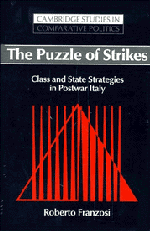Book contents
- Frontmatter
- Contents
- List of tables, figures, and equations
- Dedication
- Preface
- Acknowledgments
- 1 The puzzle box
- 2 Labor-market conditions and bargaining power
- 3 When do workers strike? How the economy matters
- 4 Organizational resources and collective action
- 5 The structure of collective bargaining
- 6 Class power, politics, and conflict
- 7 Mobilization processes: the 1969 autunno caldo
- 8 Countermobilization processes: reactions by the state and employers to strike waves
- 9 The picture in the puzzle
- Epilogue
- Appendix: the data
- Notes
- Bibliography
- Index
3 - When do workers strike? How the economy matters
Published online by Cambridge University Press: 08 January 2010
- Frontmatter
- Contents
- List of tables, figures, and equations
- Dedication
- Preface
- Acknowledgments
- 1 The puzzle box
- 2 Labor-market conditions and bargaining power
- 3 When do workers strike? How the economy matters
- 4 Organizational resources and collective action
- 5 The structure of collective bargaining
- 6 Class power, politics, and conflict
- 7 Mobilization processes: the 1969 autunno caldo
- 8 Countermobilization processes: reactions by the state and employers to strike waves
- 9 The picture in the puzzle
- Epilogue
- Appendix: the data
- Notes
- Bibliography
- Index
Summary
It can be shown for all countries for which statistics exist that strikes are somewhat sensitive to the trade cycle – indeed it would be surprising if this were not so.
Knowles (1952, p. 144)DID I GO WRONG?
Studies of the economic determinants of strikes (i.e., their relationships to the level of general economic activity) have not been based exclusively on unemployment. Actually, given the novelty of labor-force surveys in most industrialized countries, it was only in the postwar period that unemployment became the most commonly used cyclical indicator in empirical investigations of strikes. Various other economic series have been used as proxies for the business cycle: price and wage indices, the value of imported raw materials, industrial production, composite cyclical indicators, and GNP.
The empirical evidence put forward in this literature strongly supports the hypothesis of a positive relationship between strike activity and the business cycle, however measured, with one major qualification: The number of strikes is the factor that is most sensitive to business-cycle fluctuations. The findings reported in Chapter 2 confirm that strike frequency in Italy was related to the movements of real wages and unemployment. These findings run counter to those reported by David Snyder (1975) in one of the few econometric analyses of Italian strike data. According to Snyder, there is no evidence in favor of an economic model of strikes for the Italian case.
In order to address this discrepancy between Snyder's findings and my findings, in this chapter I will take up at greater length the question of economic determinants of strikes.
- Type
- Chapter
- Information
- The Puzzle of StrikesClass and State Strategies in Postwar Italy, pp. 56 - 95Publisher: Cambridge University PressPrint publication year: 1995

